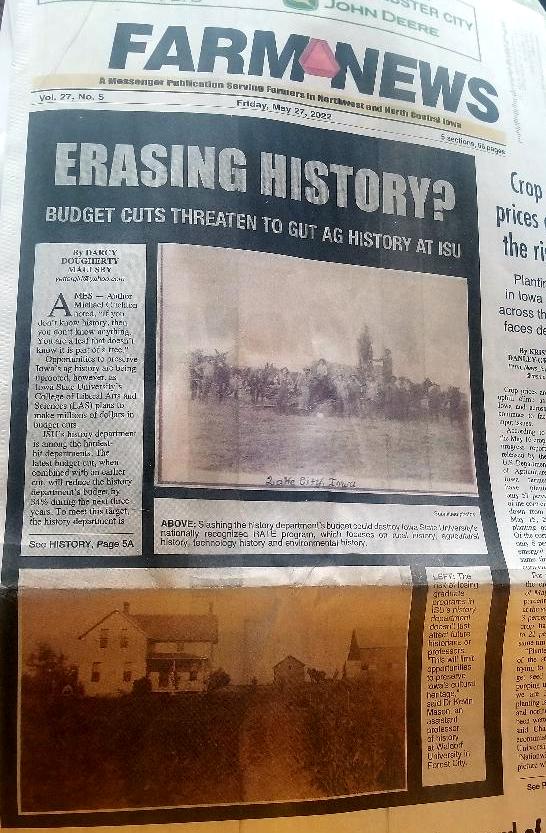
Whats HOT
Latest Posts
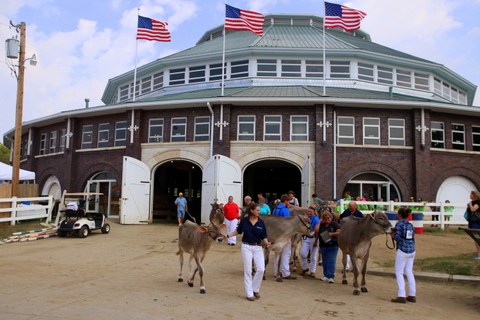
Iconic State Fair Architecture- Historic Buildings Reflect Decades of Memories
The Iowa State Fair is a homecoming for Iowans, and the historic buildings that grace the fairgrounds in Des Moines provide iconic venues for this statewide family reunion. There’s also a lot of surprising history behind many of these structures, from the Agriculture Building to the Livestock Pavilion.
“The Iowa State Fair connects generations of Iowans,” said Iowa Governor Kim Reynolds, who spoke during the opening ceremony of the 2017 Iowa State Fair on August 10. “There are so many wonderful memories and traditions here at the fair, which showcases the best of Iowa’s agricultural and cultural heritage.”
While the first Iowa State Fair was held October 25-27, 1854, in Fairfield, supported by a total operating budget of $323, the fair moved to its present location in 1886.
“The state fair moved to this site in Des Moines after the State Legislature and the City of Des Moines appropriated funds to purchase Calvin and Arminta Thornton’s farm,” said Leo Landis, state curator for the State Historical Society of Iowa, who helped lead an Iowa State Fair walking tour on Aug. 10. “One building original to the Thornton farm remains–Grandfather’s Barn, which is on the far eastern edge of the fairgrounds.”
Livestock Pavilion opened in 1902
Between the time the Fair Board purchased the land in June 1886 and when the fair opened in September 1886, crews constructed 67 buildings. “Of those, Pioneer Hall is the only one that remains today,” said Landis, museum curator at the State Historical Museum.
By the 1900 Iowa State Fair, most of the buildings built for the 1886 fair were still in use. They were beginning to show signs of decay, however, and roofs were particularly bad. It was time for the Iowa State Fair to clean up the fairgrounds.
One of the first new buildings added more than a century ago was the Livestock Pavilion. Back in 1901, more than 650 cattle were shown at the Iowa State Fair – only about 50 less than were shown that year at the International Stock Show at Chicago, Landis said. With future Iowa State Fairs expected to have even more cattle, the Iowa Legislature appropriated $37,000 for a fireproof steel-and-brick stock pavilion, similar to one that had just been constructed at the Illinois State Fairgrounds.
The Livestock Pavilion was the first major brick-and-steel structure built at the Iowa State Fairgrounds. “By constructing buildings out of these materials, the Fair Board gave the fair a sense of permanence and safety at this location,” said Landis, who noted that the new Livestock Pavilion officially opened for the 1902 fair and has been used for stock judging, lectures, entertainment and more for decades.
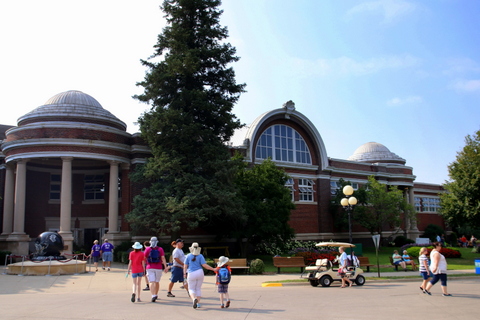
A new Agriculture Building was constructed in time for the 1904 Iowa State Fair. This famous building is home to the beloved Butter Cow. The Agriculture Building is one of the finest examples of Double Jeffersonian architecture remaining in the world.
1904 State Fair showcased new Agriculture Building
A new Agriculture Building came along two years later, in time for the 1904 Iowa State Fair. Located at the intersection of Grand Avenue and Rock Island Avenue, the Agriculture Building was built along the route to and from the State Fair from the Rock Island Railroad depot.
From the beginning, the Agriculture Building has been used as the agricultural, horticultural and dairy building. It’s home to the famous Butter Cow and other butter sculptures, which have been part of the Iowa State Fair since 1911.
“The Homestead,” a well-known farm newspaper of the late 1800s and early 1900s published in Des Moines, touted the new Agriculture Building as “one of the finest structures for exhibiting products of the farm that can be found in the Central West.”
The building’s design was inspired by the Exposition Halls at the Columbian Exposition, the world’s fair held in Chicago in 1893. The Agriculture Building is one of the finest examples of Double Jeffersonian architecture remaining in the world.
“Building a structure of such grand scale – with 33,800 square feet of floor space – suggested to visitors that the Iowa State Fair was an event of both civic and social importance,” said Jessica Rundlett, special projects and outreach coordinator at State Historical Museum of Iowa, who assisted with the Iowa State Fair walking tour.
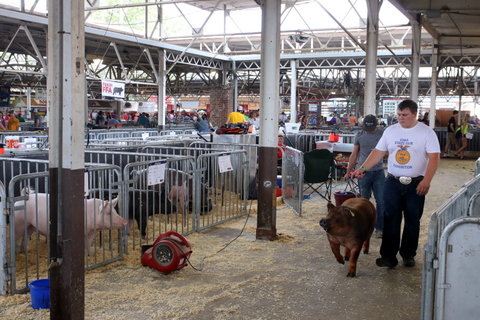
Kyle Andrews with the Wayne FFA chapter exhibited hogs during the 2017 Iowa State Fair. The Swine Barn was built in 1907.
Swine Barn design enhanced ventilation
When a new Swine Barn was constructed for the 1907 Iowa State Fair, the roof covered 185,000 square feet of stalls, exhibition areas and two central show rings that could seat more than 800 people. “The Homestead newspaper said you had to see it to believe its grand size,” Landis said.
The state appropriated $75,000 to build the Swine Barn. The building’s roof profile is designed to provide superior lighting and ventilation. The long open windows at roof level and open exterior walls draw in fresh air. Today you can see the Big Boar at the Swine Barn, as well as the Avenue of Breeds, which is coordinated by the North Polk FFA.
Horse Barn cost $25,000
The Horse Barn was completed in 1912 for $25,000 and renovated in 1929. Measuring 156 feet by 224 feet, the new barn could accommodate 132 draft horses and a like number of ponies, according to the Homestead newspaper. Th article also noted the new barn was equipped with water troughs, wash stands, sanitary feed mangers and automatic hayracks, Landis said.

The Horse Barn was completed in 1912 for $25,000 and renovated in 1929.
Cattle Barn named for Iowa farmer
The Iowa State Fair’s building boom of the early twentieth century included the new Cattle Barn, which opened for the 1914 fair. While the original barn could accommodate 108 head of cattle, the barn now has ties for 1,600 cows, thanks to multiple expansions through the years.
Among the early proponents of Iowa’s cattle industry was Iowa Governor William Larrabee of Clermont, Landis noted. Larrabee helped introduced Brown Swiss dairy cattle to Iowa after studying the breed and concluding Brown Swiss were best suited for Iowa’s climate.
Today, the Cattle Barn is named for John Putney, a farmer from Gladbrook who was also a long-time cattle exhibitor, president of the Sale of Champions and beef superintendent. Putney was appointed the first executive director of the Blue Ribbon Foundation, which has raised more than $135 million in the last 25 years to renovate and preserve the Iowa State Fairgrounds.
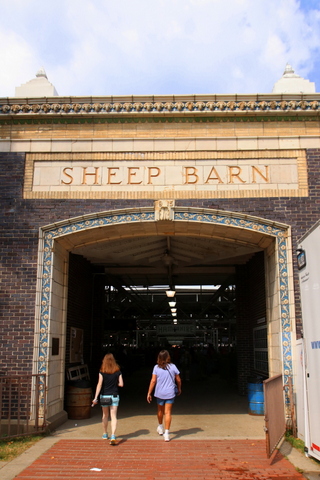
In 1915, the state legislature appropriated $14,000 to build a sheep pavilion. The Sheep Barn opened for the 1917 Iowa State Fair. The building is notable for the detailed terra cotta designs on the east façade, including a row of rams’ heads near the roof.
Sheep Pavilion opened for 1917 fair
During the Golden Age of Agriculture, state funding was available to construct a wide range of livestock barns at the Iowa State Fair. In 1915, the state legislature appropriated $14,000 to build a sheep pavilion. The Sheep Barn opened for the 1917 Iowa State Fair. The building is notable for the detailed terra cotta designs on the east façade, including a row of rams’ heads near the roof.
The legacy lives on
The Iowa State Fairgrounds was listed on the National Register of Historic Places in 1987. It’s a fitting honor for a unique venue filled with many architectural marvels. “The late Bill Wagner, a preservation architect from Iowa, noted that ‘the complex contains a representative collection of almost all architectural styles for most of the past 200 years,’” Landis said.
Historic buildings are just one of the many reasons the Iowa State Fair is the best state fair in the nation, Reynolds said. “I’m extraordinarily proud of this tradition. Remember—nothing compares to our great Iowa State Fair!”
Take a virtual tour
The Iowa State Fair Walking Tour can be found on the Iowa Culture App. Either download the app, or log onto dcaapp.com. Click on the featured tour “Star” button on the right and look for the “Iowa State Fair tour.”
Want more?
Thanks for stopping by. I invite you to read more of my blog posts if you want more more intriguing Iowa stories and history, along with Iowa food, recipes and tips to make you a better communicator. If you like what you see and want to be notified when I post new stories, be sure to click on the “subscribe to blog updates/newsletter” button at the top of this page. Feel free to share this information with friends and colleagues who might be interested, too.
If you’re hungry for more stories of Iowa history, check out my top-selling “Culinary History of Iowa: Sweet Corn, Pork Tenderloins, Maid-Rites and More” book from The History Press, as well as my Calhoun County” book from Arcadia Publishing, which showcases the history of small-town and rural Iowa. Order your signed copies today! Iowa postcards are available in my online store, too.
Let’s stay in touch. I’m at darcy@darcymaulsby.com, and yettergirl@yahoo.com.
P.S. Thanks for joining me. I’m glad you’re here.
@Copyright 2017 Darcy Maulsby & Co.
About me:
Some people know me as Darcy Dougherty Maulsby, while others call me Yettergirl. I grew up on a Century Farm between Lake City and Yetter and am proud to call Calhoun County, Iowa, home. I’m an author, writer, marketer, business owner and entrepreneur who specializes in agriculture. Learn more at www.darcymaulsby.com.

Iconic State Fair Architecture: Historic Buildings Reflect Decades of Memories
The Iowa State Fair is a homecoming for Iowans, and the historic buildings that grace the fairgrounds in Des Moines provide iconic venues for this statewide family reunion. There’s also a lot of surprising history behind many of these structures, from the Agriculture Building to the Livestock Pavilion.
“The Iowa State Fair connects generations of Iowans,” said Iowa Governor Kim Reynolds, who spoke during the opening ceremony of the 2017 Iowa State Fair on August 10. “There are so many wonderful memories and traditions here at the fair, which showcases the best of Iowa’s agricultural and cultural heritage.”
While the first Iowa State Fair was held October 25-27, 1854, in Fairfield, supported by a total operating budget of $323, the fair moved to its present location in 1886.
“The state fair moved to this site in Des Moines after the State Legislature and the City of Des Moines appropriated funds to purchase Calvin and Arminta Thornton’s farm,” said Leo Landis, state curator for the State Historical Society of Iowa, who helped lead an Iowa State Fair walking tour on Aug. 10. “One building original to the Thornton farm remains–Grandfather’s Barn, which is on the far eastern edge of the fairgrounds.”
Livestock Pavilion opened in 1902
Between the time the Fair Board purchased the land in June 1886 and when the fair opened in September 1886, crews constructed 67 buildings. “Of those, Pioneer Hall is the only one that remains today,” said Landis, museum curator at the State Historical Museum.
By the 1900 Iowa State Fair, most of the buildings built for the 1886 fair were still in use. They were beginning to show signs of decay, however, and roofs were particularly bad. It was time for the Iowa State Fair to clean up the fairgrounds.
One of the first new buildings added more than a century ago was the Livestock Pavilion. Back in 1901, more than 650 cattle were shown at the Iowa State Fair – only about 50 less than were shown that year at the International Stock Show at Chicago, Landis said. With future Iowa State Fairs expected to have even more cattle, the Iowa Legislature appropriated $37,000 for a fireproof steel-and-brick stock pavilion, similar to one that had just been constructed at the Illinois State Fairgrounds.
The Livestock Pavilion was the first major brick-and-steel structure built at the Iowa State Fairgrounds. “By constructing buildings out of these materials, the Fair Board gave the fair a sense of permanence and safety at this location,” said Landis, who noted that the new Livestock Pavilion officially opened for the 1902 fair and has been used for stock judging, lectures, entertainment and more for decades.

A new Agriculture Building was constructed in time for the 1904 Iowa State Fair. This famous building is home to the beloved Butter Cow. The Agriculture Building is one of the finest examples of Double Jeffersonian architecture remaining in the world.
1904 State Fair showcased new Agriculture Building
A new Agriculture Building came along two years later, in time for the 1904 Iowa State Fair. Located at the intersection of Grand Avenue and Rock Island Avenue, the Agriculture Building was built along the route to and from the State Fair from the Rock Island Railroad depot.
From the beginning, the Agriculture Building has been used as the agricultural, horticultural and dairy building. It’s home to the famous Butter Cow and other butter sculptures, which have been part of the Iowa State Fair since 1911.
“The Homestead,” a well-known farm newspaper of the late 1800s and early 1900s published in Des Moines, touted the new Agriculture Building as “one of the finest structures for exhibiting products of the farm that can be found in the Central West.”
The building’s design was inspired by the Exposition Halls at the Columbian Exposition, the world’s fair held in Chicago in 1893. The Agriculture Building is one of the finest examples of Double Jeffersonian architecture remaining in the world.
“Building a structure of such grand scale – with 33,800 square feet of floor space – suggested to visitors that the Iowa State Fair was an event of both civic and social importance,” said Jessica Rundlett, special projects and outreach coordinator at State Historical Museum of Iowa, who assisted with the Iowa State Fair walking tour.

Kyle Andrews with the Wayne FFA chapter exhibited hogs during the 2017 Iowa State Fair. The Swine Barn was built in 1907.
Swine Barn design enhanced ventilation
When a new Swine Barn was constructed for the 1907 Iowa State Fair, the roof covered 185,000 square feet of stalls, exhibition areas and two central show rings that could seat more than 800 people. “The Homestead newspaper said you had to see it to believe its grand size,” Landis said.
The state appropriated $75,000 to build the Swine Barn. The building’s roof profile is designed to provide superior lighting and ventilation. The long open windows at roof level and open exterior walls draw in fresh air. Today you can see the Big Boar at the Swine Barn, as well as the Avenue of Breeds, which is coordinated by the North Polk FFA.
Horse Barn cost $25,000
The Horse Barn was completed in 1912 for $25,000 and renovated in 1929. Measuring 156 feet by 224 feet, the new barn could accommodate 132 draft horses and a like number of ponies, according to the Homestead newspaper. Th article also noted the new barn was equipped with water troughs, wash stands, sanitary feed mangers and automatic hayracks, Landis said.

The Horse Barn was completed in 1912 for $25,000 and renovated in 1929.
Cattle Barn named for Iowa farmer
The Iowa State Fair’s building boom of the early twentieth century included the new Cattle Barn, which opened for the 1914 fair. While the original barn could accommodate 108 head of cattle, the barn now has ties for 1,600 cows, thanks to multiple expansions through the years.
Among the early proponents of Iowa’s cattle industry was Iowa Governor William Larrabee of Clermont, Landis noted. Larrabee helped introduced Brown Swiss dairy cattle to Iowa after studying the breed and concluding Brown Swiss were best suited for Iowa’s climate.
Today, the Cattle Barn is named for John Putney, a farmer from Gladbrook who was also a long-time cattle exhibitor, president of the Sale of Champions and beef superintendent. Putney was appointed the first executive director of the Blue Ribbon Foundation, which has raised more than $135 million in the last 25 years to renovate and preserve the Iowa State Fairgrounds.

In 1915, the state legislature appropriated $14,000 to build a sheep pavilion. The Sheep Barn opened for the 1917 Iowa State Fair. The building is notable for the detailed terra cotta designs on the east façade, including a row of rams’ heads near the roof.
Sheep Pavilion opened for 1917 fair
During the Golden Age of Agriculture, state funding was available to construct a wide range of livestock barns at the Iowa State Fair. In 1915, the state legislature appropriated $14,000 to build a sheep pavilion. The Sheep Barn opened for the 1917 Iowa State Fair. The building is notable for the detailed terra cotta designs on the east façade, including a row of rams’ heads near the roof.
The legacy lives on
The Iowa State Fairgrounds was listed on the National Register of Historic Places in 1987. It’s a fitting honor for a unique venue filled with many architectural marvels. “The late Bill Wagner, a preservation architect from Iowa, noted that ‘the complex contains a representative collection of almost all architectural styles for most of the past 200 years,’” Landis said.
Historic buildings are just one of the many reasons the Iowa State Fair is the best state fair in the nation, Reynolds said. “I’m extraordinarily proud of this tradition. Remember—nothing compares to our great Iowa State Fair!”
Take a virtual tour
The Iowa State Fair Walking Tour can be found on the Iowa Culture App. Either download the app, or log onto dcaapp.com. Click on the featured tour “Star” button on the right and look for the “Iowa State Fair tour.”
Want more?
Thanks for stopping by. I invite you to read more of my blog posts if you want more more intriguing Iowa stories and history, along with Iowa food, recipes and tips to make you a better communicator. If you like what you see and want to be notified when I post new stories, be sure to click on the “subscribe to blog updates/newsletter” button at the top of this page. Feel free to share this information with friends and colleagues who might be interested, too.
If you’re hungry for more stories of Iowa history, check out my top-selling “Culinary History of Iowa: Sweet Corn, Pork Tenderloins, Maid-Rites and More” book from The History Press, as well as my Calhoun County” book from Arcadia Publishing, which showcases the history of small-town and rural Iowa. Order your signed copies today! Iowa postcards are available in my online store, too.
Let’s stay in touch. I’m at darcy@darcymaulsby.com, and yettergirl@yahoo.com.
P.S. Thanks for joining me. I’m glad you’re here.
@Copyright 2017 Darcy Maulsby & Co.
About me:
Some people know me as Darcy Dougherty Maulsby, while others call me Yettergirl. I grew up on a Century Farm between Lake City and Yetter and am proud to call Calhoun County, Iowa, home. I’m an author, writer, marketer, business owner and entrepreneur who specializes in agriculture. Learn more at www.darcymaulsby.com.
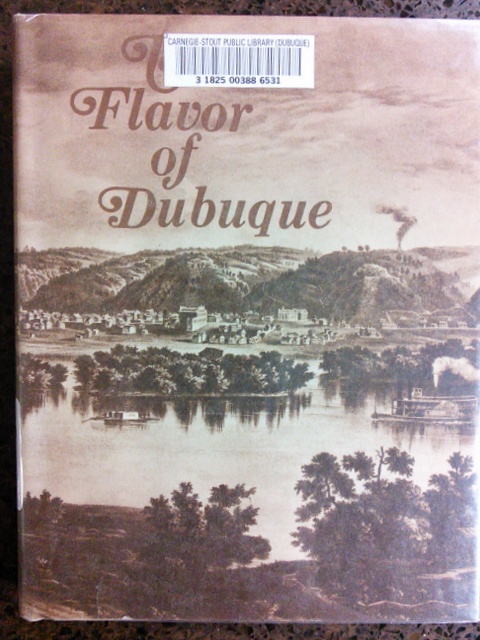
Let’s Have an Iowa Potluck with a Side of History!
Dubuque is home to some of Iowa’s most distinctive culinary traditions, from turkey dressing sandwiches to the memorable meals served at the iconic Hotel Julien Dubuque. We’re going to be eating up all this local flavor at a potluck on Sept. 7 at the Carnegie-Stout Public Library in Dubuque, starting at 5:30 p.m., followed by my “Culinary History of Iowa” program—and you’re invited!
Click here for all the details.
In meantime, here’s a sample of some classic Dubuque recipes to tempt you. These recipes come from a variety of sources, including two cookbooks (including The Flavor of Dubuque and Another Flavor of Dubuque) compiled by The Women’s Auxiliary of the Dubuque Symphony Orchestra. Not only do those cookbooks include tried-and-true local recipes, but they feature many photos of local landmarks. The third cookbook (Cedar Ridge Farm Recipes) appears to have been a collection of family recipes, and librarian Sarah Smith isn’t sure how it came to be in the Carnegie-Stout’s collection, but it’s charming.
Thanks, Sarah, for sharing these recipes and offering us a true taste of Dubuque!
One more thing–if you’re in Dubuque, stop by Cremer’s Grocery, a Dubuque classic since 1948, for their famous turkey dressing sandwiches and other goodies! Also, here are some fun facts about Dubuque, an All-American City that’s truly a “Masterpiece on the Mississippi:”
- Dubuque was settled by a French Canadian fur trader in the late 1700s named Julien Dubuque. In those days, Dubuque was known as the “gateway to the west.” Lead mining soon became the mainstay of Dubuque.
- There has been some type of hotel on the site of the Hotel Julien Dubuque since 1839.
- Some cool things to see in Dubuque include the National Mississippi River Museum and Aquarium, along with the Fenelon Place Elevator Company, which is the world’s shortest, steepest elevator ride!

Source: American Realty
The Flavor of Dubuque (published 1971)
Page 26
Derby Grange Steak. The present owners of what was the main farmstead in the area west of Dubuque long known as Derby Grange found this recipe behind an old picture of President Harding left by the previous owners. Cut 1 thick round steak into 1-inch pieces. Pound very thin and sprinkle with flour, salt, pepper, a little cumin and dill. Poud again and brown pieces on both sides in a little butter or other fat. Place in baking dish and pour over 1 cup tomato sauce. Bake, covered, at 300 degrees for 1 hour. Serves 7. Can be frozen. -Joan Mulgrew
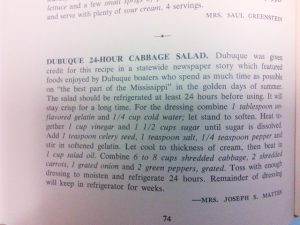
A Dubuque original –24-Hour Cabbage Salad
Page 74
Dubuque 24-Hour Cabbage Salad. Dubuque was given credit for this recipe in a statewide newspaper story which featured foods enjoyed by Dubuque boaters who spend as much time as possible on “the best part of the Mississippi” in the golden days of summer. The salad should be refrigerated at least 24 hours before using. It will stay crisp for a long time. For the dressing combine 1 tablespoon unflavored gelatin and 1/4 cup cold water; let stand to soften. Heat together 1 cup vinegar and 1 1/2 cups sugar until sugar is dissolved. Add 1 teaspoon celery seed, 1 teaspoon salt, 1/4 teaspoon pepper and 1 cup salad oil. Combine 6 to 8 cups shredded cabbage, 2 shredded carrots, 1 grated onion and 2 green peppers, grated. Toss with enough dressing to moisten and refrigerate 24 hours. Remainder of dressing will keep in refrigerator for weeks. -Mrs. Joseph S. Mattes
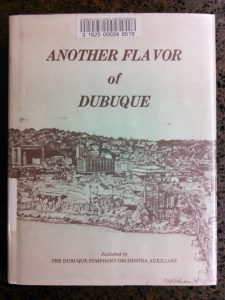
More recipes from Dubuque, Iowa
Another Flavor of Dubuque (published 1983)
Page 70
Welsh Rarebit. Shred 1/2 pound Cheddar cheese, put in double boiler and let melt slowly over hot water. Keep water below boiling point. Add 1/4 teaspoon dry mustard, paprika, salt and a few dashes cayenne pepper. Stir in 1 cup milk or cream and 1 teaspoon Worcestershire sauce. Mixture should be smooth and velvety. Serve on hot buttered toast. Strips of bacon are especially good over this.
Welsh Rarebit became a traditional Sunday night supper in the girls’ boarding school at Sinsinawa Mound (this is technically across the river in Wisconsin, but many of the students would have been from Dubuque.) The recipe’s simplicity and flexibility accommodated the varying number of returning students each Sunday night. It was sometimes served over tomatoes or ham. -Bette F. Schmid
Page 156
Dubuque Symphony Orchestra Auxiliary English Toffee. This delicious toffee was sold at the 1981 Designer Showcase, and the Auxillary has had many, many requests for the recipe. Line cookie sheet with foil. In heavy pan mix 1 cup sugar, 1/2 pound butter, 1/4 cup water, 1/4 teaspoon salt, 1/2 teaspoon vanilla and 1 cup chopped pecans. Cook quickly over medium high heat, stirring constantly, to a rolling boil. Cook to hard crack stage, 300 degrees on candy thermometer. Pour on cookie sheet. Cool and break into pieces. Store in air tight container. Do not freeze, refrigerate or make substitutions in recipe. -Mary Stauffer
Cedar Ridge Farm Recipes by Rita Tarnutzer Montgomery (published 1999)
Page 69
Chocolate Chip Cookies (Monster Cookies)
1/2 cup margarine
1/2 cup shortening
1 cup brown sugar
1 cup white sugar
1 teaspoon vanilla
2 eggs
1 cup oatmeal
1 cup corn flakes
2+ cups flour
1 teaspoon baking powder
1 teaspoon baking soda
12 ounces chocolate chips
Bake for 10-12 minutes at 350 degrees.
NOTE from Rita: For Monster Cookies, form into 5 oz. balls and flatten into 7-inch diameter circles, two to a cookie sheet. Bake for about 14 minutes at 350 degrees. Makes 8 cookies.
In 1976, when Al had his first antique shop, on 16th and Central Ave., he had a huge glass cookie jar. His idea was to display a couple of really big cookies in it. Everyone wanted to buy them! So, I began baking these monster cookies, 32 at a time and selling them for twenty-five cents each. (They cost twelve cents each to make.) I couldn’t keep up with the demand, so he raised the price to thirty-five cents and still they sold. School kids stopped on their way home from school and bought a cookie to share!
Page 159
Turkey & Dressing Sandwiches
from Janet Duscher, 12/88
Bake in a covered roaster until meat falls from bones: 1 – 12 lb. turkey
Remove meat from bones and chop.
Cook together:
1 1/2 cups cooking juices
3/4 cup margarine
2 1/2 cups chopped celery
3 medium onions, chopped
2 tablespoons sage
2 teaspoons poultry seasoning
1 – 1 ½-ounce package dry onion soup mix
1 – 10 3/4 ounces cream of chicken soup
Cube: 2 loaves of day-old bread (about 6 quarts)
Stir together bread cubes, juices with vegetables and seasonings and turkey.
Bake in a greased pan at 350 degrees until heated thoroughly, about one hour.
Serve hot in buns.
Want more?
Thanks for stopping by. I invite you to read more of my blog posts if you want more more intriguing Iowa stories and history, along with Iowa food, recipes and tips to make you a better communicator. If you like what you see and want to be notified when I post new stories, be sure to click on the “subscribe to blog updates/newsletter” button at the top of this page. Feel free to share this information with friends and colleagues who might be interested, too.
If you’re hungry for more stories of Iowa history, check out my top-selling “Culinary History of Iowa: Sweet Corn, Pork Tenderloins, Maid-Rites and More” book from The History Press, as well as my Calhoun County” book from Arcadia Publishing, which showcases the history of small-town and rural Iowa. Order your signed copies today! Iowa postcards are available in my online store, too.
Let’s stay in touch. I’m at darcy@darcymaulsby.com, and yettergirl@yahoo.com.
P.S. Thanks for joining me. I’m glad you’re here.
@Copyright 2017 Darcy Maulsby & Co.
About me:
Some people know me as Darcy Dougherty Maulsby, while others call me Yettergirl. I grew up on a Century Farm between Lake City and Yetter and am proud to call Calhoun County, Iowa, home. I’m an author, writer, marketer, business owner and entrepreneur who specializes in agriculture. Learn more at www.darcymaulsby.com.
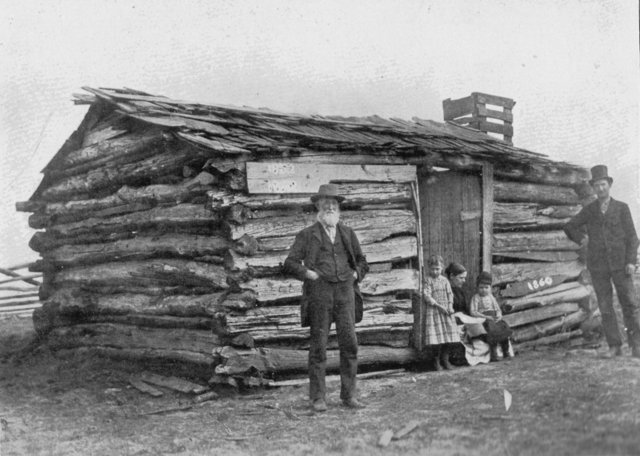
5 Ways a “History Head” Mindset Helps You Think Big
Want a secret weapon to gain more respect, get along better with others, excel at leadership, grow your business and just have more fun in life? Brush up on history.
Take it from this “history head.” A knowledge of history gives you deeper insights into yourself and others. When you become a “history head,” you gain an incalculable advantage over those who don’t have this mindset.
Here are 5 ways that becoming a “history head” will pay off and help you think big:
1. Discover the cure for the dreaded “presentism.” If you can only see the short term, you think only of the here and now. Losing all sense of perspective makes you prone to “presentism,” a sense of exaggerating present challenges out of proportion to all those challenges that have existed before.
2. Increase your odds of success. A knowledge of history is like a virtual time machine that lets you see the big picture. It’s easier to measure your current plans against things that have already occurred and weigh them against your aspirations for the future. While the nearsighted person sees only the present, and the dreamer sees only an imaginary future, often tripping over his or her mistakes trying to get there, a “history head” has a much stronger sense of reality and better chances of success.
3. Enjoy more career opportunities. History requires a complex skill set. It demands thorough research, critical thinking, and problem-solving skills. You must study and interpret a variety of sources, including politics, law, economics, sociology, psychology, the sciences and the arts, to extract meaning. These are exactly the high-level skill sets that are required in today’s top jobs.
4. Become a thought leader. Like many modern challenges in our world, history can be extraordinarily complex. In an era marred by fake news, history endows you with a healthy skepticism and a capacity to question the world around you. As you delve deeper, you almost always find unanswered questions, unclear information or missing pieces of evidence. At some point, though, you must stop researching and start developing a credible course of action. It’s like assembling a jigsaw puzzle, except there’s no picture to serve as a guide, and some of the pieces are missing. The historian, like any thought leader, must weigh the evidence, think clearly, and become a strong communicator who can express a compelling, accurate point of view.
5. Make life better. At its core, history helps you learn what it means to be human. You explore timeless issues and challenges that have impacted generations of people, both past and present. These insights equip you to better understand and work with the people in your world. Perhaps the biggest gift of all? History helps you appreciate today while building a better tomorrow.
Want more?
Thanks for stopping by. I invite you to read more of my blog posts if you want more more intriguing Iowa stories and history, along with Iowa food, recipes and tips to make you a better communicator. If you like what you see and want to be notified when I post new stories, be sure to click on the “subscribe to blog updates/newsletter” button at the top of this page. Feel free to share this information with friends and colleagues who might be interested, too.
If you’re hungry for more stories of Iowa history, check out my top-selling “Culinary History of Iowa: Sweet Corn, Pork Tenderloins, Maid-Rites and More” book from The History Press, as well as my Calhoun County” book from Arcadia Publishing, which showcases the history of small-town and rural Iowa. Order your signed copies today! Iowa postcards are available in my online store, too.
Let’s stay in touch. I’m at darcy@darcymaulsby.com, and yettergirl@yahoo.com.
P.S. Thanks for joining me. I’m glad you’re here.
@Copyright 2017 Darcy Maulsby & Co.
About me:
Some people know me as Darcy Dougherty Maulsby, while others call me Yettergirl. I grew up on a Century Farm between Lake City and Yetter and am proud to call Calhoun County, Iowa, home. I’m an author, writer, marketer, business owner and entrepreneur who specializes in agriculture. Learn more at www.darcymaulsby.com.
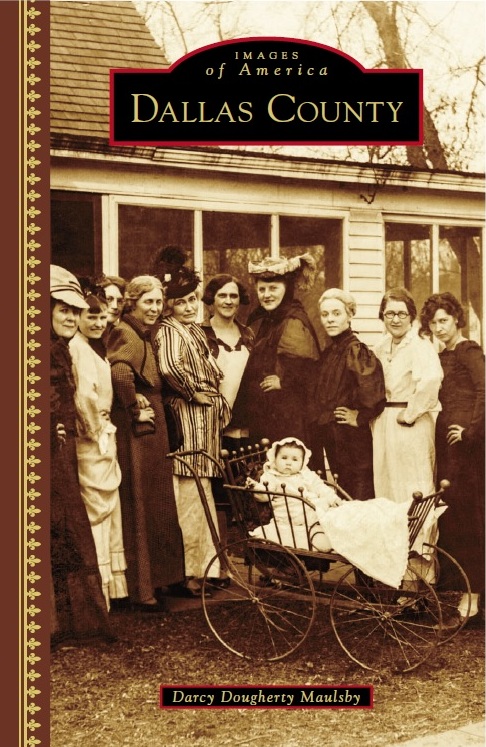
Why I’m Using a Powerful 500-Year-Old Technology to Make History–And You Can, Too
It’s always an exciting–yet nerve-wracking–moment of truth when months of research, writing and hard work end up at the one place where I have no more control—the printing press. There’s no turning back now for “Dallas County,” my third non-fiction Iowa history book, which is being printed as we speak by Arcadia Publishing, which specializes in hyper-local history. Can’t wait to show you the final result around Sept. 4!
I love the tried-and-true, old-school format of a printed, hard-cover book to share intriguing photos and the rich history of Dallas County, located just west of Des Moines. No Iowa county has influenced American history more than Dallas County. It propelled Harry Truman to an unlikely victory in the 1948 presidential campaign, following a fiery speech he delivered to 100,000 farmers on a sweltering September day at the National Plowing Match near Dexter. (Read all it about it here–along with my interview of a man who was there and took President Truman for a ride on his bulldozer!)
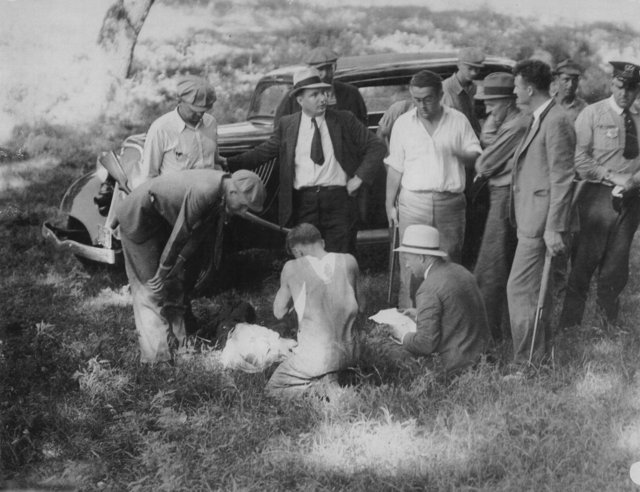
While Bonnie and Clyde escaped from the July 24, 1933, shootout with the law at the abandoned Dexfield amusement part north of Dexter, Clyde’s older brother, Buck, (shown here lying on the ground) was mortally wounded and died five days later at Kings Daughters Hospital in Perry. Buck’s wife, Blanche, was also captured at Dexfield.
Just 15 years earlier, a shoot-out near Dexfield Park marked the beginning of the end for infamous outlaws Bonnie and Clyde and the notorious Barrow Gang. (Yes, I was able to track down a lot of the crime scene photos and include them in the book, thanks to the wonderful volunteers at the terrific little Dexter Museum.)
The big-time names that have had a brush with Dallas County history don’t stop there. Dallas County has produced several major-league baseball players (among them Bob Feller and Hal Manders), a US congressman (David Young), and Nile Kinnick, the 1939 Heisman Trophy winner and University of Iowa football legend whose grandfather George Clarke, of Adel, served as Iowa’s governor from 1913 to 1917.
Today, Dallas County is one of the fastest-growing counties in America and remains a region of opportunity with a rich heritage of small-town living, farming, coal mining, and the immigrant experience. (If you like, you can pre-order the book on Amazon. If you want to wait for a signed copy, I’ll be selling them soon through my online store at my website.)
Pushing back against the dominance of digital
If you’ve got stories to share, whether for a business or for your own personal stories, why not take a look at a traditional book, or some other printed format? The print revolution is back in a big way. (Check out this great article to see what I mean.)
While digital technology swept the publishing world with the emergence of the ebook starting in 1999, inspiring some to proclaim the death of the printed book, ebook sales are plateauing. Sales of printed books are once again on the rise.
Printed books aren’t the only part of this intriguing phenomenon. Vinyl records are enjoying a rebirth, as well. This trend toward the analogue, particularly among millennials, could reflect a desire to connect to simple, tangible, non-digital things in our fast-paced, high-tech world. Perhaps it’s more of a longing to be unplugged now and then and occasionally tuned out. Whatever it foretells, the news that printed books are back is welcome here!
Want more?
Thanks for stopping by. I invite you to read more of my blog posts if you want more more intriguing Iowa stories and history, along with Iowa food, recipes and tips to make you a better communicator. If you like what you see and want to be notified when I post new stories, be sure to click on the “subscribe to blog updates/newsletter” button at the top of this page. Feel free to share this information with friends and colleagues who might be interested, too.
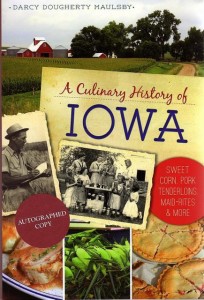 If you’re hungry for more stories of Iowa history, check out my top-selling “Culinary History of Iowa: Sweet Corn, Pork Tenderloins, Maid-Rites and More” book from The History Press, as well as my Calhoun County” book from Arcadia Publishing, which showcases the history of small-town and rural Iowa. Order your signed copies today! Vintage and rural Iowa postcards are available in my online store, too.
If you’re hungry for more stories of Iowa history, check out my top-selling “Culinary History of Iowa: Sweet Corn, Pork Tenderloins, Maid-Rites and More” book from The History Press, as well as my Calhoun County” book from Arcadia Publishing, which showcases the history of small-town and rural Iowa. Order your signed copies today! Vintage and rural Iowa postcards are available in my online store, too.
Let’s stay in touch. I’m at darcy@darcymaulsby.com and yettergirl@yahoo.com.
P.S. Thanks for joining me. I’m glad you’re here.
@Copyright 2017 Darcy Maulsby & Co.
About me:
Some people know me as Darcy Dougherty Maulsby, while others call me Yettergirl. I grew up on a Century Farm between Lake City and Yetter and am proud to call Calhoun County, Iowa, home. I’m an author, writer, marketer, business owner and entrepreneur who specializes in agriculture. Learn more at www.darcymaulsby.com.
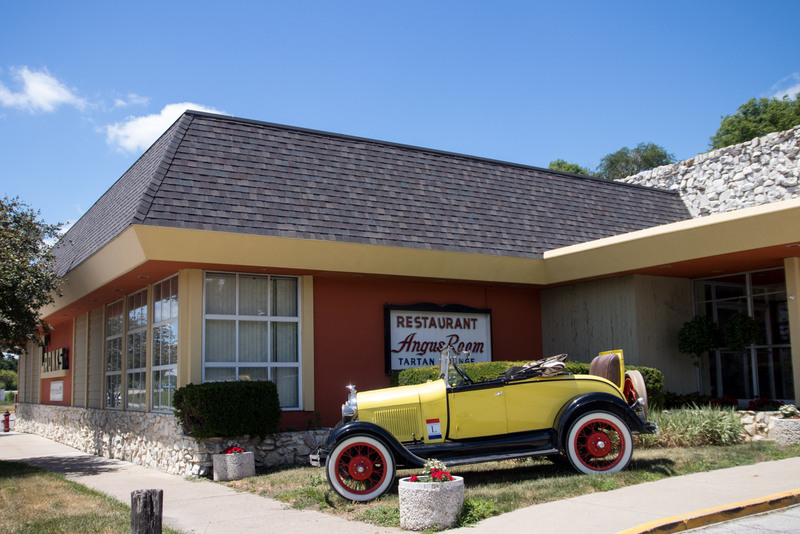
Cruising Through Forgotten Iowa History on Lincoln Highway
If you ever travel U.S. Highway 30 across Iowa, you’re never far away from the Lincoln Highway, if not right on top of it. If you’ve ever driven on Interstates 80 or 35, you’re also enjoying a legacy of fast, efficient transportation that took root with the Lincoln Highway more than 100 years ago.
I was reminded of the Lincoln Highway’s pivotal role when I shared my “Culinary History of Iowa” program with 100+ Lincoln Highway enthusiasts from New York to California who met in Denison from June 20-24 for the Lincoln Highway Association’s 2017 annual conference. As attendees shared their stories with me, it was clear the Lincoln Highway’s magic hasn’t waned through the decades.
Perhaps we should all thank the founders of the Lincoln Highway for helping get rural Iowa out of the mud. Oh, that mud!
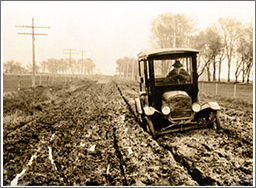
It’s obvious why Iowa needed to get out of the mud 100+ years ago.
As late as 1912, road conditions in the United States and Iowa were often deplorable, especially in rural areas. Few roads in the countryside were graded, and maintenance fell to those who lived along them.
The lack of paved roadways meant travel was always dominated by the weather. In wet weather, roads turned to mud and became impassable. During the winter months, you could be stranded on the farm for weeks if snowdrifts blocked the roads.
Iowans, like most Americans, were frustrated by poor road conditions, especially as the automobile’s popularity took off. Indiana native Carl Graham Fisher envisioned a solution. A tireless promoter of the automobile industry, Fisher had a track record of success, having joined a group of Indianapolis businessmen who invested in what became the Indianapolis Motor Speedway.
At a dinner meeting in 1912 in Indianapolis, Fisher proposed the idea of a highway that would span America from coast to coast. Stretching nearly 3,400 miles, this “rock highway” named in honor of President Abraham Lincoln would follow the shortest, fastest, most practical route. Fisher’s goal was to finish the highway by the 1915 Panama-Pacific Exposition. The highway’s path would run from New York City to the Exposition’s host city of San Francisco.
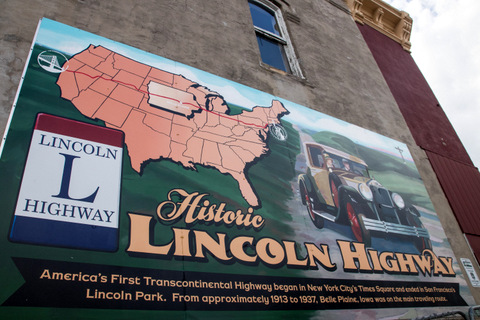
Belle Plaine, Iowa, celebrates its rich Lincoln Highway history.
Established in 1913, the Lincoln Highway transformed automobile travel from a tortuous journey to an exciting adventure. In Iowa, the Lincoln Highway was built from Clinton to Council Bluffs, connecting the Main Streets of 43 communities along the way.
As the first coast-to-coast highway, the Lincoln Highway demonstrated the power of good roads for transportation and commerce. It accelerated the Good Roads Movement, which helped get Iowa and other states out of the mud. On a national scale, the Federal Highway Administration and interstate highway system decades later marked the culmination of these efforts.
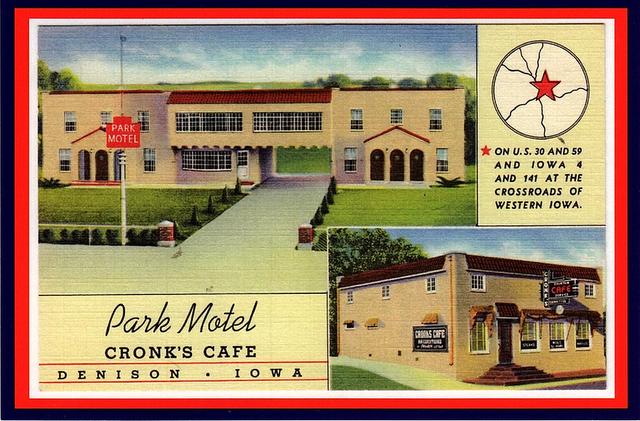
This vintage postcard shows the historic Park Motel and Cronk’s Cafe in Denison along the Lincoln Highway.
While interstates often offer the fastest way to crisscross Iowa today, I’ve been taking the backroads, including the Lincoln Highway, on some of my recent excursions around Iowa. I got a kick out of “Travel Tips from the Past” that the Iowa Lincoln Highway Association recently posted on its website and also appeared in a Washington Post article. While these road-trip gems were first promoted in the early 1900s by etiquette maven Emily Post and fellow motorists Effie Gladding and Beatrice Larned Massey, they still hold true today:
• Stop on a whim. If you see an intriguing café, go in. I recently stopped at the Lincoln Café in Belle Plaine and enjoyed a delicious bowl of vegetable beef and noodle soup, an Italian beef sandwich and coleslaw, along with a side of history. This café has served locals and travelers since 1928.
• Pause to take in the view. It usually takes me awhile to get to my destination, because I stop often to capture rural Iowa’s beauty with my camera.

The Reed-Niland Corner in Colo has served travelers since the 1920s and is likely the only remaining spot on the entire Lincoln Highway that still features a café (try their homemade ham-and-bean soup and a slice of pie!), vintage gas station and motel.
• Eat local. I love supporting locally-owned businesses that preserve the history of the Lincoln Highway, from the Santa Maria Winery in Carroll to the fabulous Reed-Niland Corner in Colo. This Story County treasure has served travelers since the 1920s and is likely the only remaining spot on the entire Lincoln Highway that still features a café (try their homemade ham-and-bean soup and a slice of pie!), vintage gas station and motel.
No matter where your summer road trips take you in Iowa and beyond, long live the legacy of the iconic Lincoln Highway!
This story first appeared in my Farm News column in June 2017.
Want more?
Thanks for stopping by. I invite you to read more of my blog posts if you want more more intriguing Iowa stories and history, along with Iowa food, recipes and tips to make you a better communicator. If you like what you see and want to be notified when I post new stories, be sure to click on the “subscribe to blog updates/newsletter” button at the top of this page. Feel free to share this information with friends and colleagues who might be interested, too.
If you’re hungry for more stories of Iowa history, check out my top-selling “Culinary History of Iowa: Sweet Corn, Pork Tenderloins, Maid-Rites and More” book from The History Press, as well as my Calhoun County” book from Arcadia Publishing, which showcases the history of small-town and rural Iowa. Order your signed copies today! Iowa postcards are available in my online store, too.
Let’s stay in touch. I’m at darcy@darcymaulsby.com.
P.S. Thanks for joining me. I’m glad you’re here.
@Copyright 2017 Darcy Maulsby & Co.
About me:
Some people know me as Darcy Dougherty Maulsby, while others call me Yettergirl. I grew up on a Century Farm between Lake City and Yetter and am proud to call Calhoun County, Iowa, home. I’m an author, writer, marketer, business owner and entrepreneur who specializes in agriculture. Learn more at www.darcymaulsby.com.
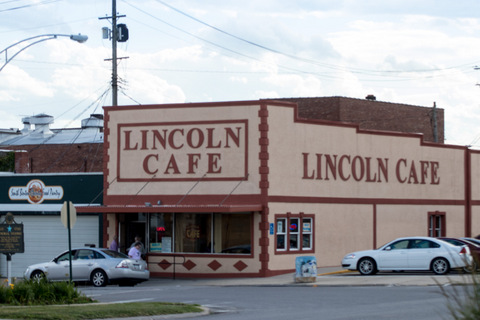
The historic Lincoln Cafe in Belle Plaine has served home-cooked food along the Lincoln Highway since 1928.
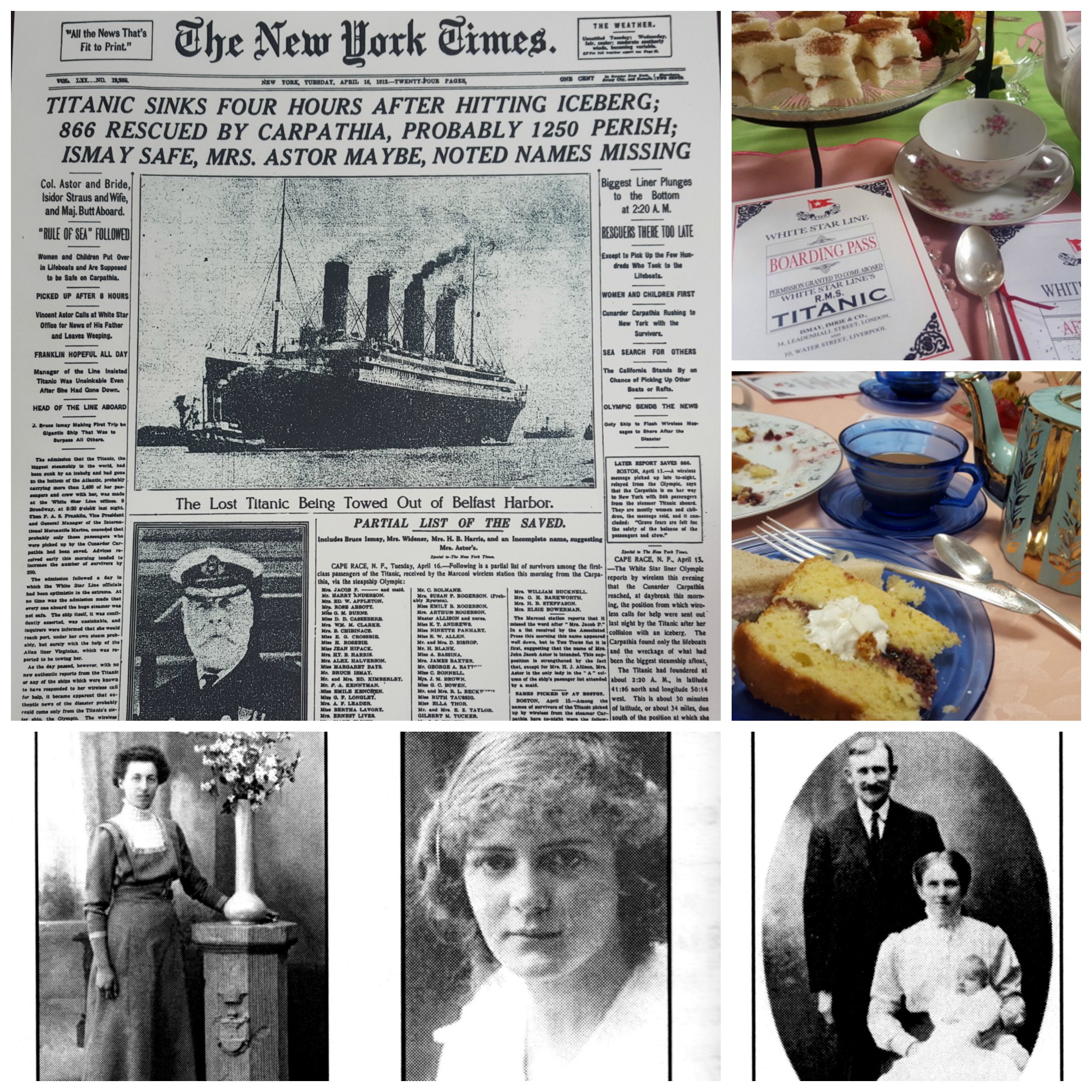
Iowa’s Lost History from the Titanic
I perished on the Titanic, yet I’ve lived to tell the forgotten stories of Iowa’s ties to one of the most famous luxury liners in history. It all started when I attended the Johnson County H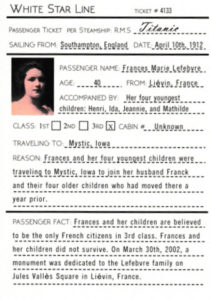 istorical Society’s “Afternoon Tea on the Titanic” in April 2, 2017, and my boarding pass said I was third-class passenger Frances Lefebvre, 40, of Lievin, France.
istorical Society’s “Afternoon Tea on the Titanic” in April 2, 2017, and my boarding pass said I was third-class passenger Frances Lefebvre, 40, of Lievin, France.
As Lefebvre, my four youngest children and I were traveling to Mystic, Iowa, to join my husband, Franck, and our for older children who had moved to Iowa a year prior. I died, along with my four youngest kids, during the sinking of Titanic in the early-morning hours of April 15, 1912.
I was not alone. Of the approximately 2,207 passengers who boarded the Titanic, only an estimated 705 survived. Like Frances Lefebvre, a number of Titanic’s passengers had ties to Iowa. Here are their stories.
Titanic survivor, Orphan Train rider kept low profile in Council Bluffs
One of Titanic’s last living survivors lived in Council Bluffs for decades and rarely spoke of the maritime tragedy or her connection to the Orphan Train Movement.
Helen Delaney’s remarkable story began when she was thrown overboard as Titanic sank. Someone caught the 4-year-old, and she survived the night, although her parents perished. While the family had boarded the ship in England, the names of Delaney’s birth parents are unknown, and Delaney’s didn’t know her exact birth date, according to a 2012 news report in the Council Bluffs Daily Nonpareil.
With the other Titanic survivors, Delaney arrived in New York on April 18, 1912, where she was placed in an orphanage. James P. Delaney, a Council Bluffs locomotive engineer for the Chicago, Burlington & Quincy Rail Company (now BNSF), and his wife adopted the girl after she arrived in Council Bluffs via an orphan train sometime in the mid to late 1910s.
 Orphan trains brought thousands of children to Iowa and beyond
Orphan trains brought thousands of children to Iowa and beyond
Children on these orphan trains ranged in age from about six to 18, and they shared a common grim existence. There was little hope of a successful future for these kids if they stayed in the streets, slums and orphanages of New York City.
Their numbers were staggering. An estimated 30,000 children were homeless in New York City as early as the 1850s. The plight of these abandoned, neglected children commanded the attention of a young minister named Charles Loring Brace. He believed that by removing youngsters from the poverty of the city and placing them with Christian farm families, these children could have a chance of escaping a lifetime of suffering.
Brace, who founded the Children’s Aid Society, proposed that these children be sent by train to live and work on farms out west. They would be placed in homes for free but they wouldn’t be indentured.
Children like Helen Delaney boarded westbound trains in groups of up to 40, accompanied by two agents from the Children’s Aid Society. Advertisements appeared in local newspapers along the route in advance of each orphan train’s arrival. When the trains stopped, the children were paraded in front of the crowd and took turns giving their names, singing a song or “saying a piece,” according to “Lost Children: Riders on the Orphan Train,” an article that appeared in HUMANITIES magazine in November/December 2007.
Although the strong demand for the orphans was often motivated by a need for labor, the Children’s Aid Society took pains to ensure the children were well cared for. Families applying to take children had to be endorsed by a committee of local business owners, doctors and other respected community members. Representatives from the society would visit each family once a year to check on conditions, and children were expected to write letters back to the society twice a year, noted the “Lost Children” article.
The Orphan Train Movement, which lasted from 1853 to 1929, placed nearly a quarter of a million children in new homes across the country. This ambitious, unusual social experiment is now recognized as the beginning of the foster care concept in the United States. While some of the children struggled in their newfound surroundings, many others like Helen Delaney went on to lead successful, normal lives as they worked towards the American dream.
Delaney attended school in Council Bluffs, including Mount Loretto Catholic High School. She remained in Council Bluffs, never married and never had children. She lived in anonymity in an apartment at Regal Towers on South Sixth Street, according to the Council Bluffs Nonpareil.
For much of her adult life, Delaney worked as a sales clerk at the Kresge’s five-and-dime store. Only a few people in town knew that this petite, shy, nice clerk had survived Titanic. “She rarely talked about her Titanic legacy,” Dick Warner of the Historical Society of Pottawattamie County told the Council Bluffs Nonpareil in 2012. “Most people who knew her weren’t even aware of it.”
Delaney died on January 26, 1982, at age 74 and was buried at St. Joseph Cemetery off McPherson Avenue in Council Bluffs. She was the only known passenger on Titanic to live in Council Bluffs.
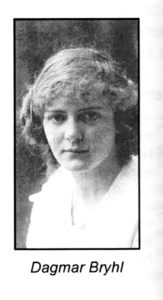
Picture from the book “Not My Time to Die” by Lilly Setterdahl
“Life no longer has any value for me”
Like Delaney, many of Titanic’s survivors and victims were immigrants headed to America to begin a new life. In other cases, the travelers were only planning to visit before returning to Europe. Such was the story of second-class passenger Dagmar Lustig Bryhl, 20, who looked forward to attending a wedding in Red Oak, Iowa, and visiting her uncle Oscar Lustig in Rockford, Illinois, before returning to Sweden.
Author Lilly Setterdahl of East Moline, Illinois, has captured the often heartbreaking—and sometimes heroic—stories of Bryhl and the 122 other Swedes on board Titanic in her fascinating 2012 book, Not My Time to Die. I listened for any tidbits connected to Iowa as Setterdahl related many of these stories during the “Afternoon Tea on the Titanic” in Iowa City.
Consider the letter Bryhl wrote to her uncle while she recuperated in New York following the Titanic disaster (as documented in Not My Time to Die, page 119). Bryhl became so distraught that she wished she had been permitted to die on Titanic with her fiancé, Ingvar Enander, and brother, Kurt.
Dear Uncle,
Titanic has gone down. I don’t know whether my fiancé and my brother Kurt are saved. Evidently, they are not, for most of the men went under. I am at a hospital but am not sick, although very feeble. I have lost everything. I have no clothes, and so cannot get up, so must lie in bed for present.
I would have been glad if I had been permitted to die, because life no longer has any value for me since I lost my beloved. I feel myself so dreadfully alone in this land. These people are certainly good, but nevertheless do not understand me.”
Bryhl asked her uncle to come find her, which he did. Bryhl required bed rest after the long, tiresome journey to Rockford, and she refused to talk to reporters. Her uncle related bits and pieces of her story to local newspapers.
“I was in my berth when the Titanic hit the berg. I noticed the jar and soon I heard Ingvar [her fiancé] knocking on the door of my cabin.“Get up, Dagmar,” he said. “The ship has hit something.” I put on a skirt and coat as quickly as possible and hurried up to the deck. But the officers said, “Go back, there is no danger, you go to your cabins.”
Bryhl returned to her berth and went back to bed. Soon there was more knocking on her door.
“Get up, Dagmar, we are in danger!” Ingvar yelled. “I don’t care what the ship’s officers say. The boat is sinking.”
After pulling on her skirt and coat and running from her berth, Bryhl heard awful screaming and yelling. Women and children were being loaded into lifeboats. Men and women were kissing each other farewell. Ingvar and Kurt led Bryhl to a lifeboat, and Ingvar lifted his fiancé into the boat. She seized his hands and wouldn’t let go. “Come with me!” Bryhl screamed as loud as she could, still holding Ingvar’s hands tight. There was room in the lifeboat, which was only half full. Suddenly an officer ran forward and clubbed back Ingvar.
“This officer tore our hands apart, and the lifeboat was let down. As it went down, I looked up. There, leaning over the rail stood Kurt and Ingvar side by side. I screamed to them again, but it was no use. They waved their hands and smiled. That was the last glimpse I had of them.”
As the men in the lifeboat rowed the boat away from Titanic, the passengers shivered in the frigid night air as they watched the great ship sink.
“Then more dreadful screams,” said Bryhl, who recalled that the sea was so still it was clear as a mirror beneath the cloudless sky. “The water filled with crying people. Some of them climbed in our boat and so saved their lives.”
The small group of survivors huddled in the lifeboat until 6 a.m. on Monday, April 15, when the Carpathia arrived. Hours in the freezing air without adequate clothing to protect against the stinging cold numbed Bryhl’s body.
According to her uncle, Bryhl declared repeatedly between hysterical sobs that she never would have allowed her brother and fiancé to put her in the lifeboat if she thought the two men would be lost. She said she would rather have died with them when the great ship settled into the depths than to live with the memory of all that took place.
Bryhl returned home to Sweden in May 1912 after only a short time in Rockford. She later married a teacher named Eric Holmberg. She died in August 1969, Setterdahl noted.
 “Not my time to die”
“Not my time to die”
During “Afternoon Tea on the Titanic,” Setterdahl (a native Swede herself) also detailed the life of 22-year-old Anna Nysten, the woman whose story provided the title for Setterdahl’s book.
Nysten had planned to leave Sweden in the summer of 1912 to visit her sister Klara in Passaic, New Jersey. However, some of Nysten’s friends who were headed to America that spring persuaded her to go with them. Nysten traveled with the Andersson family from Kisa, Sweden, and the Danbom family from Stanton, Iowa. Nysten would be the lone survivor of the 11-member group.
“I can hardly describe how it happened,” Nysten wrote to her parents in the wake of the Titanic disaster. “There was terrible screaming and groaning, but you and I ought to thank God that I am alive. I managed to get into a lifeboat because I don’t think it was my time to die. I’m supposed to experience more of the world.”
Nysten offered more details of the disaster after Titanic struck the iceberg (as documented in Not My Time to Die, pages 167-169).
“There was a terrible jolt, so we nearly fell out of bed. But then they said it was not serious, so the passengers calmed down until the ship began to sink and the deck was full of people.”
After someone took Nysten’s lifebelt and she began crying, a sailor gave her his life jacket. While her traveling companions proclaimed they would all go down together with the ship, a sailor pushed Nysten into a lifeboat.
“Oh, how terrible it was when everything went dark,” said Nysten, who recalled that her lifeboat could have held 63 people but only had about 40 passengers when it was lowered into the sea. “When the ship went down we were not far away and were almost sucked under.”
Nysten and the others in the lifeboat heard an awful rumbling noise as the great ship sank. They sat in the lifeboat from 1:30 a.m. to 6:30 a.m., but “fortunately the sea was calm,” she recalled.
“You can imagine how happy we were to see the steamer Carpathia close in on us and we could come aboard. They were so good to us.”
The survivors were given blankets, coffee and brandy (“as much as we wanted,” Nysten noted).
“But there was still much groaning and crying because most of us had lost a dear relative,” Nysten recalled. “Many became hysterical.”
In New York, Nysten was taken to the Swedish Immigrant Home, where she received $25 from the Women’s Relief Committee. Nysten spent three years in New York with friends and intended to return to Sweden, but when the Lusitania was torpedoed in 1915, she changed her mind. She came to Boone, Iowa, and moved to Des Moines in 1916, where she married Arvid Gustafson in 1917. The couple had three sons and were members of the First Lutheran Church in Des Moines.
Nysten was one of the few Titanic survivors who married, had children and was not reluctant to talk about her Titanic experience, although it took several years after the sinking before she was willing to share many of those haunting memories, Setterdahl noted. In 1937 on the 25th anniversary of the tragedy, Nysten said in a newspaper interview that she no longer dreamed about the disaster.
Nysten passed away March 28, 1977, and is buried in Resthaven Cemetery in West Des Moines.
“The lifeboats were all gone”
Some Swedes on the Titanic like Gunnar Tenglin were returning to their adopted home in Iowa. Tenglin, 25, had grown up in Sweden and emigrated to America around 1903 at age 16. He settled in Burlington, Iowa. Until he learned to speak English he worked with crews cutting ice on the Mississippi River. He learned English while working at the Horace Patterson farm.
Tenglin returned to Sweden in 1908 where he married his wife, Anna. A year after the couple’s son, Gunnar, was born in Stockholm in 1911, Tenglin made plans to return to Burlington. He acquired a third-class ticket to travel on Titanic. Tenglin considered third class on Titanic equal to first class on most other steamers, noted Setterdahl, who documents his story in Not My Time to Die, pages 191-194.
Late in the evening of April 14, 1912, Tenglin and his traveling companion, August Wennerstrom (a fellow Swede who would also survive the sinking) had come back from a party on board Titanic. Tenglin had just taken off his shoes and was preparing for bed when he felt a thud. He put his jacket on but left his shoes in his bunk and his lifejacket under his pillow. He never returned for them.
When he came up on deck, all the lifeboats were gone. An officer on deck engaged Tenglin as an interpreter since the Swede knew English. Tenglin thought that saved him, as noted in a 2012 Burlington Hawk Eye article, because he was still on deck translating the officer’s commands to other Swedes. Otherwise, he may have been below deck when the ship when down.
Tenglin, a tall man of medium build with light blue eyes and brown hair, provided specific details of that unforgettable night to the Burlington Daily Gazette in 1912:
“It looked to us as if we were doomed to perish with the ship when a collapsible lifeboat was discovered. This boat would hold about 50 people, and we had considerable trouble getting it loose from its fastenings. The boat was on the second deck, and the ship settled the question of its launching, as the water suddenly came up over the deck and the boat floated.”
The terror was far from over, though.
“There must have been 150 people swimming around or clinging to the boat, and we feared it would collapse or sink,” Tenglin said. “We had no oars or anything else to handle the boat and were at the mercy of the waves, but the sea was calm.”
There was no way to sit down, so the boats passengers stood up in knee-deep, ice-cold water. Basic survival instincts dominated the horrific scene.
“Those on the edges pushed the frantic people in the water back to their fates, it being feared they would doom us all,” Tenglin said.
A big Swede named Johnson was kept busy throwing corpses overboard, Tenglin added, since the survivors wanted to make the boat as light as possible to increase its buoyancy.
Tenglin and other passengers in Collapsible A were rescued by the Carpathia. When the ship arrived in New York, the American Red Cross and the Swedish American Society took pictures of the surviving immigrants and printed the images as picture postcards. Tenglin sent one of those postcards to his mother in Sweden, mailing it from Burlington on April 29, 1912.
Tenglin lived the rest of his life in Iowa, where he was joined by his wife and son who arrived from Sweden in 1913. Tenglin worked various jobs during his career, from the railroad to the local utility plant that supplied Burlington with gas. Tenglin passed away in 1974 at age 86 in Burlington and is buried in Aspen Grove Cemetery.
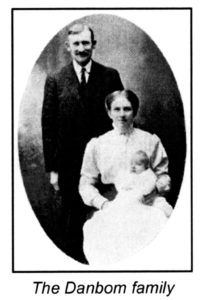 Immigrant recruiter buried in Stanton, Iowa
Immigrant recruiter buried in Stanton, Iowa
Other Swedes on board Titanic did not have the opportunity to live a long, full life. On pages 231-233 of Not My Time to Die, Setterdahl relates the sad fate of Ernest Danbom, a 34-year-old farmer and immigrant recruiter who was born and raised in Montgomery County, Iowa.
The son of two Swedish immigrants who farmed in southwest Iowa, Danbom married his wife, Anna, in 1910. The newlyweds traveled to Sweden for their honeymoon and remained with Anna’s family for a number of months. During this time, Anna gave birth to the couple’s son, Gilbert, in Kisa, Sweden, on November 16, 1911.
By April 1912, the young family prepared to return to America. Danbom also assumed the role of tour conductor for a group of 11 Swedes (including Anna Nysten and the Andersson family) who were traveling on Titanic.
As an immigrant recruiter, Danbom received a commission from each person he encouraged to come to America. Even after paying approximately $68 for a family cabin on Titanic, Danbom was carrying a substantial amount of money (including $276 in cash and $30 in gold) when he left Sweden, according to Not My Time to Die. He hoped that the money would help his family acquire a fruit farm in Turlock, California.
Tragically, none of the young family would survive the sinking of Titanic. Danbom’s wife and young son were lost at sea. Danbom’s body was recovered and brought to Halifax in Canada before being sent to Stanton, Iowa, for burial.
The Halifax coroner listed among his personal effects a black overcoat, dark suit, white pleated shirt, black boots, wedding ring marked “S.B.T.E.G.D., June 6, ’10,” gold watch and chain, knife, keys, opal and ruby ring, fountain pen, bracelet, ladies watch and chain, 3 memo books, solitaire diamond ring, scissors, U.S. naturalization papers, pocketbook, jewel case, and a check for $1,315.79, Security Bank, Sioux City.
Danbom is buried in the cemetery in Stanton. The inscription on his tombstone reads, “Ernest Danbom, 26 Oct 1877, died 15 April 1912, in Titanic disaster, his remains were recovered from the ocean. “Nearer My God to Thee.”
“No, I must be a gentleman”
In Cedar Rapids, attention focused on the well-known Douglas family, who endured an excruciating wait to learn the fate of Walter Douglas, 50, and his second wife, Mahala, first-class passengers on Titanic.
Walter Douglas was son of the founding partner of The Quaker Oats Company in Cedar Rapids. In 1903, Douglas and his brother George, founded the Douglas Starch Works, which produced cooking starch and oil, laundry starch, animal feed, soap stock and industrial starches.
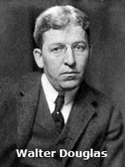 After celebrating Christmas 1911 with the Douglas family at the Brucemore mansion in Cedar Rapids, Walter and Mahala traveled to Europe for a three-month vacation to celebrate Walter’s retirement, according to Brucemore historic site and community cultural center, which has preserved this history. While in Europe, the couple also purchased furnishings for their mansion on a bluff overlooking Lake Minnetonka near Minneapolis, Minnesota.
After celebrating Christmas 1911 with the Douglas family at the Brucemore mansion in Cedar Rapids, Walter and Mahala traveled to Europe for a three-month vacation to celebrate Walter’s retirement, according to Brucemore historic site and community cultural center, which has preserved this history. While in Europe, the couple also purchased furnishings for their mansion on a bluff overlooking Lake Minnetonka near Minneapolis, Minnesota.
The couple bought first-class tickets for themselves and their French maid, Berthe Leroy, to return home aboard Titanic in time to celebrate Walter’s birthday on April 21 with family. First-class tickets on Titanic ranged from roughly $150 for a simple berth–about $3,600 today, based on current inflation tables, to $4,350 (more than $100,000) for one of the two Parlour suites.
On the night Titanic struck the iceberg, Walter and Mahala had just returned to their suite from the first-class dining room when they heard the engines stop. After Mahala asked Walter to find out what was going on, she donned her fur coat and boots to wait in the hallway. Seeing no officers and receiving no orders, Mahala grew concerned and returned to her cabin for a life preserver. Walter returned and teased her about the preserver, but agreed they should go on deck together. The couple watched as the distress rockets shot high into the air and burst into a shower of light.
Passengers on deck remained calm as they boarded the lifeboats. As Mahala climbed into a lifeboat, she requested that Walter join her. “No, I must be a gentleman,” he said before joining a group of men waiting for another lifeboat. Dressed in his tuxedo, Walter was last seen helping women and children into the final lifeboats.
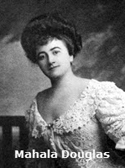 After Titanic sank, initial reports of the disaster were sparse and contradictory. The limits of wireless communication and the isolation of the disaster limited accurate information. When news of the tragedy reached Cedar Rapids, the magnitude of the disaster and the fate of Walter and Mahala were unknown.
After Titanic sank, initial reports of the disaster were sparse and contradictory. The limits of wireless communication and the isolation of the disaster limited accurate information. When news of the tragedy reached Cedar Rapids, the magnitude of the disaster and the fate of Walter and Mahala were unknown.
“The news of Titanic’s disaster came at noon while we were at luncheon,” noted an April 15 diary entry written by Irene Douglas, Walter’s sister-in-law who lived at Brucemore. “Did not seem serious until evening about 7:30 – spent the evening at the [Cedar Rapids] Republican [newspaper] office.”
Hearing no news, Irene and her husband, George, left Cedar Rapids on April 16 to meet the Carpathia, which was carrying Titanic survivors to New York. On April 17, the Cedar Rapids Evening Gazette reported:
“Up to 1 o’clock today no definite news had been received in Cedar Rapids concerning the fate of Mr. Walter D. Douglas…. The wireless telegraph companies having great trouble in effecting communication with the Carpathia…. It appears that a considerable number of the first and second cabin passengers, especially the men, must have perished, but it is still hoped that Mr. Douglas was among the ones rescued. Mrs. Douglas is on the Carpathia, but whether Mr. Douglas went down with the boat, as did many others of the male passengers, remains to be determined.”
On April 18, thousands of people waited in the rain in New York as the ship bearing approximately 700 Titanic survivors slowly approached the dock.
“Carpathia landed 7 in the eve.,” Irene noted in her diary. “Walter not with Mahala.”
Eight days after the sinking, the Douglas family received word on April 23 that Walter’s body had been recovered by the cable ship MacKay Bennett, the same ship that recovered the body of Wallace Hartley, whose seven-member band played as Titanic sank.
The Mackay-Bennett recovered 306 bodies near the scene of the sinking, including the body of Walt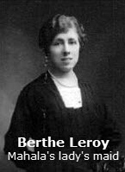 er Douglas, who was identified by his monogrammed shirt and cigarette case. The ship’s crew recorded the following information:
er Douglas, who was identified by his monogrammed shirt and cigarette case. The ship’s crew recorded the following information:
• No. 62 – MALE – Estimated age, 55 – Hair grey
• Clothing – Evening dress, with “W.D.D.” on shirt.
• Effects – Gold watch; chain; gold cigarette case “W.D.D.”; five gold studs; wedding ring on finger engraved “May 19th ’84”; pocket letter case with $551
(Interesting side note: The Mackay-Bennett was at sea working on a French trans-Atlantic cable when it got the charter from Titanic’s owners, White Star Line, to join the recovery efforts. After returning to Halifax, Nova Scotia, in Canada to pick up a hold full of ice to refrigerate bodies, 100 coffins, canvas sacks, an undertaker, and embalming fluids and equipment, the Mackay-Bennett headed out to sea to search for Titanic victims in a mission continually hampered by fog, heavy waves and wind. With its supply of coffins quickly filled and a steady stream of bodies being brought aboard by crewmen who went out in lifeboats, the Mackay-Bennett had to borrow canvas sacks and more embalming supplies from other recovery ships. The Mackay-Bennett buried at sea 116 of the 306 bodies it recovered, likely because they were not in good enough shape to be taken to Halifax. The ship took 190 victims to Halifax, where unclaimed bodies were buried in various cemeteries.)
Walter Douglas’ remains were taken first to his home in Minneapolis, then via a special train to Cedar Rapids for entombment in the Douglas family vault at Oak Hill Cemetery.
Mahala returned to her home on Lake Minnetonka, accompanied only by her maid, Berthe Leroy. An advocate of arts and culture, Mahala supported many local charities and made a donation in Walter’s name to Coe College in Cedar Rapids. A talented writer, Mahala published a collection of stories and poems in 1932. One copy, inscribed to George and Irene Douglas, is stored in the Brucemore archives. The last poem in the book is a haunting account of Titanic’s demise.
Titanic
The sea velvet smooth, blue-black,
The sky set thick with stars unbelievably brilliant.
The horizon a clean-cut circle.
The air motionless, cold – cold as death.
Boundless space.
A small boat waiting, waiting in this vast stillness,
Waiting heart-breakingly.
In the offing a vast ship, light streaming from her portholes.
Her prow on an incline.
Darkness comes to her suddenly.
The huge black hulk stands out in silhouette against the star-lit sky.
Silently the prow sinks deeper,
As if some Titan’s hand,
Inexorable as Fate,
Were drawing the great ship down to her death.
Slowly, slowly, with hardly a ripple
Of that velvet sea,
She sinks out of sight.
Then that vast emptiness
Was suddenly rent
With a terrifying sound.
It rose like a column of heavy smoke.
It was so strong, so imploring, so insistent
One thought it would even reach
The throne of grace on high.
Slowly it lost its force,
Thinned to a tiny wisp of sound,
Then to a pitiful whisper….
Silence.
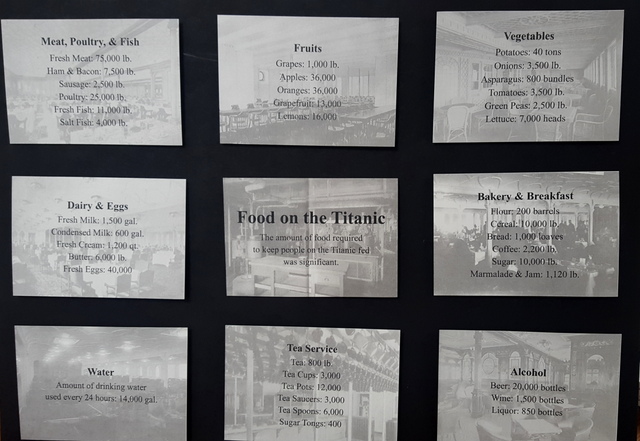 Food for thought as Titanic’s legacy lives on
Food for thought as Titanic’s legacy lives on
While more than 100 years have passed since Titanic plunged to the bottom of the sea, interest in the magnificent ship never wanes. In fact, Titanic II, a faithful replica of the doomed ship, is preparing for passengers by 2018.
The brainchild of Australian billionaire Clive Palmer, Titanic II will have practically the same dimensions of the original Titanic, which would be on the smaller side of modern cruise ships. (Shrewdly, the Titanic II will have more lifeboat capacity than the original ship.)
When Titanic II makes its maiden voyage from Jiangsu, China, to Dubai, no doubt it will offer exceptional meals, just as its predecessor did. The original Titanic’s provisions included 75,000 pounds of fresh meat, 11,000 pounds of fresh fish, 4,000 pounds of salted and dried fish, 7,500 pounds of bacon and ham, 40,000 fresh eggs, 40 tons of potatoes, 2,200 pounds of coffee, 10,000 pounds of sugar and 250 barrels of flour.
When I sampled an unforgettable taste of Titanic in Iowa City during the Johnson County Historical Society’s “Afternoon Tea on the Titanic,” one of my favorite menu items was the Victoria Sponge Cake.
“This cake is everyone’s favorite,” declares Penelope Carlevato in her book Tea on the Titanic: 100 Years Later. “No leftovers when you serve this cake.” I can see why, especially with this cake’s light texture and sweet filling that’s perfect with homemade jam (my favorite) or your best store-brought preserves.
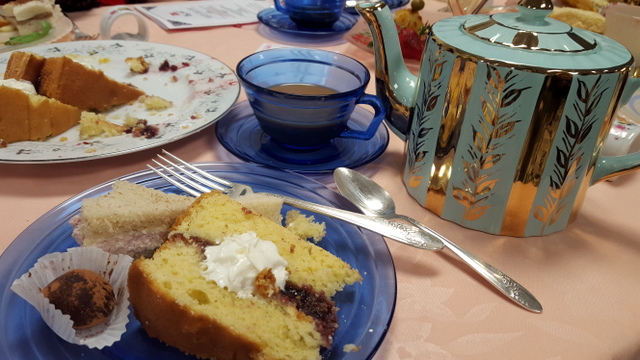
Victoria Sponge Cake served at the Johnson County Historical Society’s “Afternoon Tea on the Titanic” in Iowa City on April 2, 2017
Victoria Sponge Cake
Cake:
1 cup unsalted butter (at room temperature)
1 cup granulated sugar
4 eggs, beaten
2 cups self-rising flour, sifted flour
Filling:
1 cup jam, preserves or lemon curd (or whipping cream, if you desire)
Powdered sugar
Cream butter and sugar until light and fluffy. Add eggs and mix well. Grease and line two 8-inch round cake pans with parchment paper. Divide batter between the pans and smooth the tops for evenness.
Bake 20 to 25 minutes at 375 degrees Fahrenheit. Cool for 10 to 15 minutes in pans; then turn cakes out onto wire racks to continue cooling.
Place a paper doily on a footed cake plate. Sandwich bottoms of cake together with jam or preserves (strawberry preserves, raspberry preserves or apricot jam work well). Whipping cream could be substituted for the jam, if desired. Sprinkle top of cake with powdered sugar.
Decorate cake plate with chemical-free flowers such as violets or nasturtiums, if desired. (Wash the flowers well before use.)
Want more Iowa culture and history?
Read more of my blog posts if you want more Iowa stories, history and recipes, as well as tips to make you a better communicator.
If you’re hungry for more stories of Iowa history, check out my top-selling “Culinary History of Iowa: Sweet Corn, Pork Tenderloins, Maid-Rites and More” book from The History Press, as well as my Calhoun County” book from Arcadia Publishing, which showcases the history of small-town and rural Iowa. Order your signed copies today! Iowa postcards are available in my online store, too. Coming soon in September 2017–my third Iowa history book! Watch for more details on “Dallas County” from Arcadia Publishing.
P.S. Thanks for joining me. I’m glad you’re here.
@Copyright 2017 Darcy Maulsby & Co.


Learning from the Land: 9 Surprising Ways Farmers Make Conservation a Priority
Spring planting will soon arrive here in Iowa, but planting our Calhoun County fields isn’t the only thing on my mind. My family is always looking for ways to embrace conservation and better manage our land, because we understand the benefits of improved water quality and soil sustainability extend far beyond our fields.
This mindset defines any true steward of the land, and Iowa is blessed with an abundance of conservation-minded farmers. This is reflected in the Iowa Environmental Leader Award, which recognizes the exemplary voluntary efforts of Iowa’s farmers who are committed to healthy soils and improved water quality.
We were honored to receive a 2016 Iowa Environmental Leader Award last August at the Iowa State Fair from Iowa’s governor, lieutenant governor, Iowa Department of Agriculture and Land Stewardship staff and Iowa Department of Natural Resources staff. It was inspiring to see how many other progressive, dedicated farm families across Iowa are redefining the sustainable nature of modern agriculture.
Learning from the land is just part of my DNA. My great-great grandfather, John Dougherty, emigrated from Ireland and settled in Calhoun County north of Lake City in 1889. He purchased 200 acres, and history records that he “placed the land under a high state of cultivation,” a legacy my family carries on today with our Century Farm.
I’m also guided by the philosophy of another Iowan, Aldo Leopold, whose “land ethic” called for a principled, caring relationship with nature. “When we see land as a community to which we belong, we may begin to use it with love and respect,” noted Leopold, author of the Sand County Almanac.

The residue of the previous year’s crop helps hold our precious soil in place and builds organic matter in the soil.
Here are 9 ways that Iowa farm families like mine are putting this land ethic into practice:
1. Building on a legacy of conservation. Iowa agriculture reflects a long history of people helping the land. The process accelerated in 1935, when the Soil Conservation Service was created in the U.S. Department of Agriculture. In this era, young men with the Civilian Conservation Corps (CCC) worked on hundreds of Iowa farms to assist with soil-erosion-control projects, such as terracing hills, digging ponds, repairing gullies and planting trees for wind breaks. In 1948, more than 100,000 farmers from across the Midwest flocked to the National Soil Conservation Field Days in Dexter, Iowa, to learn new conservation practices. Even President Harry Truman made an appearance see farmers’ conservation efforts first-hand. (You can read more about it in my blog post “Riding with Harry,” where I interviewed a young Iowan who escorted Truman on a bulldozer in the fields.) While much has changed in farming since the 1930s and 1940s, one thing endures—our commitment to be good stewards of the land and keep our land productive for generations to come.
2. Prioritizing soil health. I’m convinced that unlocking the secrets of the soil is the next frontier in farming. As world population and food production demands rise, keeping our soil healthy and productive is of paramount importance. By using cover crops, diverse rotations and other systems, more Iowa farmers are increasing their soil’s organic matter while improving microbial activity. As a result, farmers are increasing water infiltration, controlling runoff and enhancing soil health—all while harvesting better yield and profit potential.
3. Balancing the three-legged stool of sustainability. Successful farm management involves environmental sustainability, economic sustainability and social sustainability that benefits not only our farm, but our community, state and beyond. Without all of those three legs, the sustainability stool falls down. That’s why my family has invested in a number of best-management practices, including soil testing to better manage fertilizer applications, grassed waterways and grassed field borders to help control soil erosion, conservation tillage, drainage water management, and the addition of windbreaks and shelterbelts. These practices help improve soil health, prevent erosion, boost yield potential and keep nutrients in place where they can nourish our crop and protect Iowa’s water quality.
4. Learning from others. I’m blessed to live in the epicenter of agriculture, where farmers have a strong support network to help enhance their conservation and farm management strategies. I value input from Iowa State University Extension, Iowa Farm Bureau Federation, Iowa Soybean Association, Iowa Corn Growers Association, MaxYield Cooperative’s SciMax Solutions, Natural Resources Conservation Service, Practical Farmers of Iowa and other trusted organizations. In my roles as a freelance ag journalist and president of the Calhoun County Farm Bureau and Calhoun County Corn Growers, I enjoy meeting with other conservation-minded farmers across the state who are willing to question current management practices and never stop asking, “Is there a better way?”
5. Finding conservation-minded urban partners. As Iowans, we’re all in this together when it comes to conservation. I applaud the City of Storm Lake for its city-wide plan emphasizing green infrastructure practices. These practices include bioreactors, which essentially function like large “coffee filters” to help improve water quality. The results are impressive. City manager Jim Patrick tells me that Storm Lake has seen a bioreactor remove 45 percent of the nitrates coming off agricultural land in the area. Storm Lake has also hosted “reverse field days” so farmers, soil and water conservation groups and others can see the progress that’s being made. “These partnerships are vital, because rural and urban communities are in this together,” Patrick told me. “It’s not city water or ag water; it’s all our water.”
6. Focusing on continuous improvement. A spirit of continuous improvement contributes to long-term success in any business, including our farm. My dad, Jim Dougherty, served as a township committee member with the Agricultural Stabilization and Conservation Service, the forerunner of USDA’s Natural Resources Conservation Service. Dad was also quick to see the value of conservation tillage and other practices that make the farm productive and sustainable. Today, we are using precision ag tools to maximize production and conservation. We never stop seeking solutions.
7. Developing a conservation philosophy. If you never try something different, how do you know if you’re maximizing your investment on every acre? My conservation philosophy is to keep learning, help my family do our best to protect Iowa’s precious soil and water resources, and pass on a legacy of conservation to future generations.
8. Providing leadership. We’ve hosted numerous media professionals at our farm, from the local newspaper to USA Today and “Market to Market,” to share what we’re doing to promote conservation and protect soil and water quality. In 2015, I also worked with the Iowa Food and Family Project to coordinate and host Expedition Yetter, a bus tour of farms in west-central Iowa that allowed urban Iowans to see conservation in action. (Watch “Market to Market’s” Expedition Yetter and water quality video here.) That same year, I also testified before the U.S. Senate Small Business Committee in Washington, D.C. to explain to federal lawmakers how conservation plays a key role on my family’s farm.
9. Enjoying the journey. Enhanced conservation, like improved farm management, is a quest that never ends. I value the legacy of farmland that was passed on to my family from previous generations and enjoy the challenge of maximizing our acres. With all the technology available today, it’s exciting to see what’s next as we keep learning from the land to enhance the sustainable nature of modern agriculture.
Darcy Dougherty Maulsby is a proud member of a Century Farm family, author, entrepreneur, business owner, and farm leader from Lake City. Visit her online at www.darcymaulsby.com.
* This editorial first appeared in the April 9, 2017, Sunday edition of the Fort Dodge Messenger.
P.S. Thanks for joining me. I’m glad you’re here.
@Copyright 2017 Darcy Maulsby & Co.
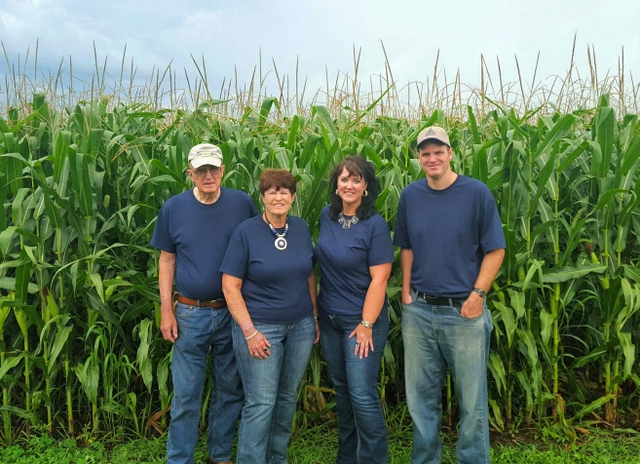
My family (including my dad, Jim, my mom, Jan, me and my younger brother, Jason, on our Calhoun County Century Farm.
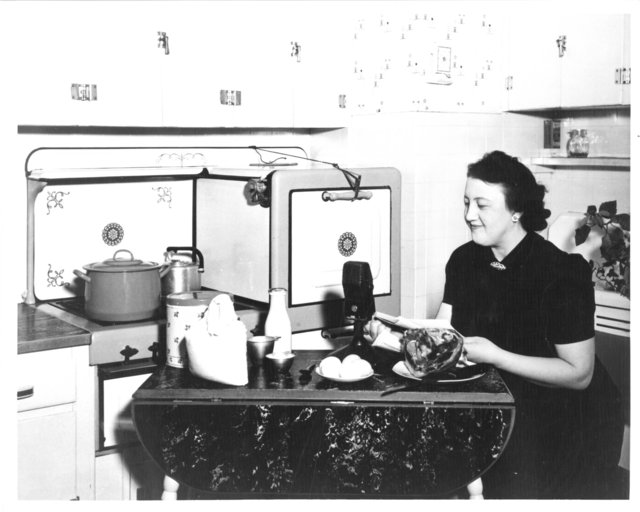
Cooking with Iowa’s Radio Homemakers
Long before there was Martha Stewart, there were KMA’s radio homemakers. These creative, talented ladies from southwest Iowa revolutionized women’s roles far beyond their humble farm kitchens starting in the 1920s. As they delighted Midwestern audiences by sharing their favorite recipes and providing down-home, daily visits with their radio friends, some of the women also became successful entrepreneurs along the way.
Their story begins in the early 1920s with the debut of a fabulous new invention called radio. In 1925, when a local businessman named Earl May began broadcasting KMA Radio-960 from Shenandoah, Iowa, to promote his seed and garden business. The station gained a following by airing practical information designed to help with the day-to-day life in Midwestern farm kitchens.
Before long, KMA was a trusted friend throughout the wide listening area, offering inspiration, companionship, and all manners of domestic counsel. The power of this connection can’t be understated when you consider the era—a time when farm wives were much more isolated than today due to poor roads, limited social opportunities and long days filled with endless chores.
A roster of personable, lively women who quickly became known as the KMA Radio Homemakers hosted KMA’s daily radio programs, including the Home Hour, the Stitch and Chat Club, and the KMA Party Line, while live cooking demonstrations drew thousands to the KMA auditorium in Shenandoah.
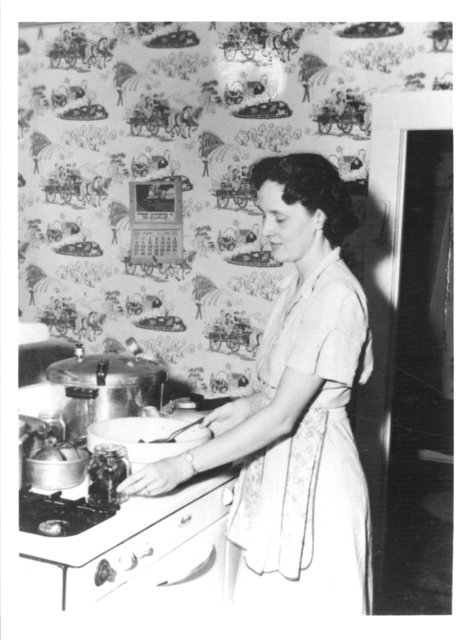
Evelyn Birkby was one of the beloved radio homemakers from southwest Iowa.
Broadcasts reached across the Midwest
The radio homemakers’ history is also linked to Earl May’s local competitor, Henry Field, another nursery and garden entrepreneur who seized on the power of radio to help expand his business. Field recruited family members to go on the air, including his sister, Leanna Field Driftmier, who began broadcasting “The Mother’s Hour,” which became “Kitchen Klatter.” Without any training, Leanna sat down at the microphone and just started talking about her home, family, recipes, household tips, advice for child- rearing and whatever news seemed worth sharing during the afternoon show.
In 1930, Leanna broke her back in a car accident but wanted to continue her show, despite her injuries. The radio equipment was brought to her home, and she broadcast from her bed and later from her kitchen table. The show became so popular amongst listeners that it was eventually was broadcast in six Midwestern states.
Neighboring on the air
As the radio homemakers’ concept gained momentum, local farm women like Evelyn Birkby began broadcasting from their kitchens in the 1950s. In her show “Down a Country Lane” on KMA Radio, Birkby would discuss her family and share snippets from her daily life, as well as offer suggestions for making the home a more pleasant place to live. Birkby called this phenomenon “neighboring on the air,” and it met a vital need when farm life could often be isolating.
Fans would follow the doings of favorite homemakers for years, tuning in each day the same way they’d listen to episodes of radio soap operas. Of course, recipes figured prominently in the broadcasts, with old-fashioned, Midwestern fare focused on meat and potatoes, hearty casseroles, cakes, pies, cookies and more.
Kitchen Klatter became home-grown success
Through the years, a line of Kitchen Klatter products (including food flavorings, bleach and more) was developed and sold over the radio by broadcasters like Leanna Driftmier. In addition, a monthly Kitchen Klatter magazine was circulated to thousands of Midwestern readers who enjoyed the articles, letters and recipes like Company Ham and Potatoes, Emerald Mint Sauce (made from Kitchen Klatter Mint Flavoring), Mary’s Pineapple Pie and Grandma’s Oatmeal Cookies. The Kitchen Klatter enterprise and the radio homemakers endured for a number of years, with some of the broadcasts lasting until the 1990s.
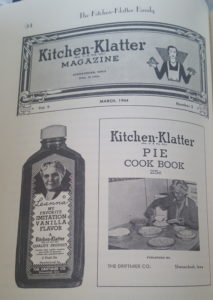 Recipes preserve a taste of Iowa history
Recipes preserve a taste of Iowa history
In 1991, Evelyn Birkby published the fascinating book “Neighboring on the Air,” where you can almost hear the voices of the KMA homemakers while you get a taste of their philosophy of life and sample their recipes. You can learn how to make hearty Midwestern fare ranging from Sour Cream Apple Pie from Florence Falk, “The Farmer’s Wife,” to Six-Layer Washday Dinner from Doris Murphy, who took to the air in 1949 with her “Party Line” broadcast.
You’ll get a sense what a grueling schedule the radio homemakers often endured as they broadcast radio shows out of their kitchen while their own family life went on about them. These ladies also knew the needs and interests of their audience, because they, too, were well acquainted with hard work, hard times and making do.
Through it all, the radio homemakers were Martha Stewart and Dear Abby all rolled into one as they shared news about their children, home beautification tips and their trusted recipes. Thousands of devoted listeners depended on them for weekly entertainment, information, humor and continuity. These listeners considered the radio homemakers a valued part of their lives, which is reflected in the longevity of the radio shows. The radio homemakers’ remarkable contributions are an enduring legacy to power of Iowa farm women and add unforgettable flavor to Iowa’s rich culinary heritage.
Six-Layer Washday Dinner
Like today’s busy working women, Iowa’s radio homemakers like Doris Murphy knew the value of being able to put a hearty, nutritious meal on the table without a lot of fuss. No doubt her recipe featured home-grown and home-canned vegetables.
2 cups hamburger
1 small onion, chopped
2 cups diced potatoes, raw
½ cup uncooked rice
1 cup sweet peppers, cut fine
1 cup diced carrots, raw
1 pint tomatoes
Brown hamburger and onion together. Combine meat, onion, potatoes, rice, peppers, carrots and tomatoes. Season with salt and pepper. Cover with water. Cook 2 hours in 350-degree oven.
Want more Iowa culture and history?
Read more of my blog posts if you want more Iowa stories, history and recipes, as well as tips to make you a better communicator.
If you’re hungry for more stories of Iowa history, check out my top-selling “Culinary History of Iowa: Sweet Corn, Pork Tenderloins, Maid-Rites and More” book from The History Press, as well as my Calhoun County” book from Arcadia Publishing, which showcases the history of small-town and rural Iowa. Order your signed copies today! Iowa postcards are available in my online store, too.
P.S. Thanks for joining me. I’m glad you’re here.
@Copyright 2017 Darcy Maulsby & Co.
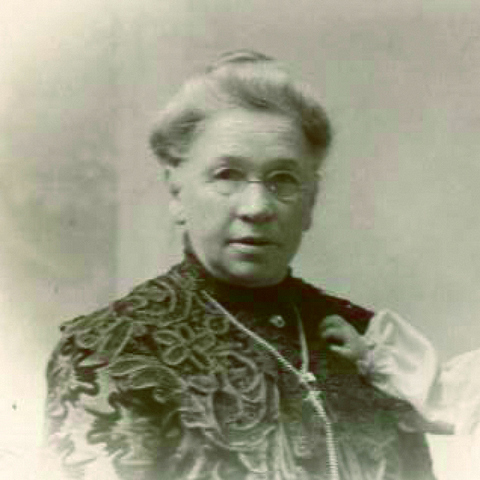
Iowa’s Ice Queen: Entrepreneur Caroline Fischer’s Legacy Endures at Hotel Julien Dubuque
Long before there was an International Women’s Day, there was Caroline (Rhomberg) Fischer, a savvy, spirited entrepreneur from Dubuque. After her husband died in 1875, the 31-year old widow and mother of five literally took the reins of her late husband’s ice delivery business—and you won’t believe what she did next.
You get a taste of Caroline’s remarkable story when you dine at Caroline’s Restaurant (named in her honor) in the historic Hotel Julien Dubuque. As you savor your banana bread French toast (yes, I recommend it!), it’s amazing to think a hotel or inn has occupied the present site of Hotel Julien Dubuque (at the corner of Second and Main Street) since 1839.
Caroline became part of the hotel’s storied history in the late 1800s. While Victorian-era ideals dictated that a woman’s place was in the home, sheer necessity—and a healthy dose of moxie—ensured that Caroline would break the mold.
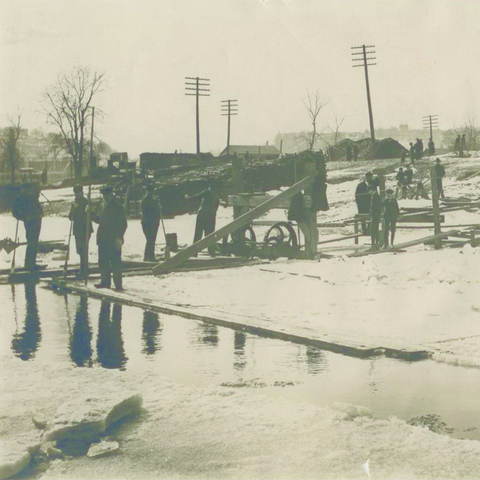
Cutting ice, a common winter job in Iowa in the 1800s and early 1900s
Death, drinking and destiny
In the days before electric freezers and electric refrigeration, Caroline’s husband, Louis, was a partner in the Fischer ice business. After Louis contracted pneumonia and died in 1875 after falling into the Mississippi River while cutting ice, Caroline took over his ice business. The 31-year-old widow with five young children also took control of her family’s destiny.
Caroline is said to have followed her ice deliverymen around town in her own horse-drawn buggy to be sure her men were doing their work properly. The many taverns to which they delivered would offer drinks to the drivers in an effort to persuade them to leave a little extra ice. On occasion, upon finding the drivers passed out in the ice wagon, Caroline would drive their team of horses and wagon back to the ice storage warehouse herself with her own horse and buggy in tow.
In 1878, long before the Fischer Company owned the Hotel Julien, the Fischer Wheeler & Co. ice business had a contract with the Hotel Julien Dubuque to supply ice to the guesthouse, then under management of W.W. Woodworth. The three-year contract was for “all the ice necessary” for $25 a month or $300 for the entire year.
Leaving a legacy
Caroline eventually bought out her partners, invested in downtown and riverfront property, and brought her family into the business that still exists today. Located in view of the Ice Harbor, where the Fischer family business started, Caroline’s Restaurant at the Hotel Julien Dubuque today honors the family matriarch of the Fischer/Pfohl families.
The Pfohl connection goes back to 1962, when the hotel was purchased by Louis H. Pfohl. After extensive remodeling, many interesting and historic artifacts were incorporated into the décor, including the stunning stained glass that’s now displayed in Caroline’s Restaurant.
The menus at Caroline’s Restaurant are influenced by what’s grown locally and what’s readily available. The talented culinary team at the restaurant also focuses on making dishes as aesthetically pleasing as they are delicious. This attention to detail and commitment to excellence is a fitting tribute Caroline, the great-great-grandmother of the three cousins who today manage the Fischer Companies and the Hotel Julien Dubuque, a landmark of Iowa history.
Savor more Iowa food history
Want more great Iowa food stories, history and recipes? Check out my top-selling “Culinary History of Iowa” book from The History Press, and order your signed copy today.
P.S. Thanks for joining me. I’m glad you’re here.
@Copyright 2017 Darcy Maulsby & Co.
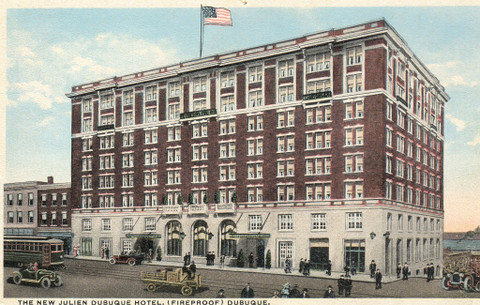
Hotel Julien Dubuque, circa 1915, Dubuque, Iowa


